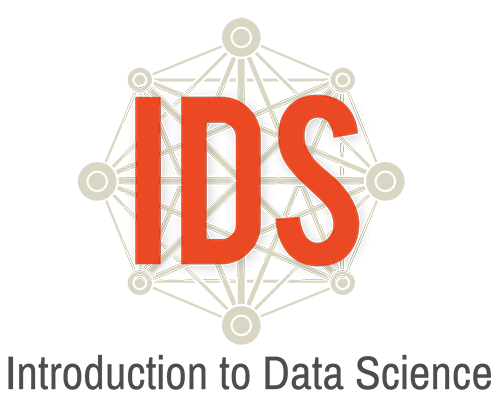Introduction to Data Science Daily Overview: Unit 4

Unit 4
Daily Overview: Unit 4
| Theme | Day | Lessons and Labs | Campaign | Topics | Page |
|---|---|---|---|---|---|
| Campaigns and Community (5 days) |
1 | Lesson 1: Trash | Modeling to answer real world problems, official data sets | 315 | |
| 2 | Lesson 2: Drought | Exploratory data analysis, campaign creation | 319 | ||
| 3 | Lesson 3: Community Connection | Team Campaign—data | Community topic research, campaign creation | 321 | |
| 4 | Lesson 4: Evaluate and Implement the Campaign | Team Campaign—data | Statistical questions, evaluate & mock implement campaign | 323 | |
| 5 | Lesson 5: Refine and Create the Campaign | Team Campaign—data | Revise and edit campaign, data collection | 325 | |
| Predictions and Models (13 days) |
6 | Lesson 6: Statistical Predictions Using One Variable | Team Campaign—data | One-variable predictions using a rule | 328 |
| 7 | Lesson 7: Statistical Predictions by Applying the Rule | Team Campaign—data | Predictions applying mean square deviation, mean absolute error | 333 | |
| 8 | Lesson 8: Statistical Predictions Using Two Variables | Team Campaign—data | Two-variable statistical predictions, scatterplots | 335 | |
| 9 | Lesson 9: The Spaghetti Line | Team Campaign—data | Estimate line of best fit, single linear regression | 337 | |
| 10 | LAB 4A: If the Line Fits… | Team Campaign—data | Estimate line of best fit | 339 | |
| 11 | Lesson 10: What’s the Best Line? | Team Campaign—data | Predictions based on linear models | 343 | |
| 12 | LAB 4B: What’s the Score? | Team Campaign—data | Comparing predictions to real data | 345 | |
| 13 | LAB 4C: Cross-Validation | Team Campaign—data | Use training and test data for predictions | 346 | |
| 14 | Lesson 11: What’s the Trend? | Team Campaign—data | Trend, associations, linear model | 348 | |
| 15 | Lesson 12: How Strong Is It? | Team Campaign—data | Correlation coefficient, strength of trend | 351 | |
| 16 | LAB 4D: Interpreting Correlations | Team Campaign—data | Use correlation coefficient to determine best model | 353 | |
| 17 | Lesson 13: Improving Your Model | Team Campaign—data | Non-linear regression | 355 | |
| 18 | LAB 4E: Some Models Have Curves | Team Campaign—data | Non-linear regression | 357 | |
| Piecing it Together (4 days) |
19 | Lesson 14: More Variables to Make Better Predictions | Team Campaign—data | Multiple linear regression | 359 |
| 20 | Lesson 15: Combination of Variables | Team Campaign—data | Multiple linear regression | 361 | |
| 21 | LAB 4F: This Model Is Big Enough for All of Us | Team Campaign—data | Multiple linear regression | 364 | |
| 22 | Practicum: Predictions | Team Campaign—data | Linear regression | 365 | |
| Decisions, Decisions! (3 days) |
23 | Lesson 16: Footbal or Futbol? | Team Campaign—data | Multiple predictors, classifying into groups, decision trees | 369 |
| 24 | Lesson 17: Grow Your Own Decision Tree | Team Campaign—data | Decision trees based on training and test data | 371 | |
| 25 | LAB 4G: Growing Trees | Team Campaign—data | Decision trees to classify observations | 374 | |
| Ties that Bind (3 days) |
26 | Lesson 18: Where Do I Belong? | Team Campaign—data | Clustering, k-means | 379 |
| 27 | LAB 4H: Finding Clusters | Team Campaign—data | Clustering, k-means | 382 | |
| 28 | Lesson 19: Our Class Network | Team Campaign—data | Clustering, networks | 385 | |
| End of Unit Project (7 days) |
29- 36 |
End of Unit 4 Modeling Activity Project and Presentation | Team Campaign | Synthesis of above | 388 |
^=Data collection window begins.
+=Data collection window ends.